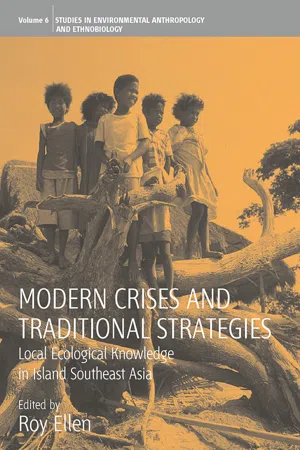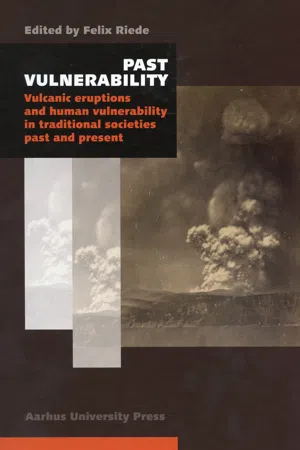Geography
Mount Merapi Eruption 2010
Mount Merapi, an active volcano in Indonesia, erupted in 2010, causing widespread damage and loss of life. The eruption lasted for several months and resulted in the evacuation of thousands of people from the surrounding area. The disaster highlighted the need for effective disaster management and response strategies in volcanic regions.
Written by Perlego with AI-assistance
Related key terms
1 of 5
6 Key excerpts on "Mount Merapi Eruption 2010"
- eBook - ePub
Disaster Relief in the Asia Pacific
Agency and Resilience
- Minako Sakai, Edwin Jurriëns, Jian Zhang, Alec Thornton(Authors)
- 2014(Publication Date)
- Taylor & Francis(Publisher)
Part IIILocal cultural knowledge and the mediaPassage contains an image
Priyambudi Sulistiyanto8The politics of the Mount Merapi eruption in Central Java, Indonesia1Introduction
This chapter analyses the politics of the 2010 Mount Merapi eruption by examining the responses of national and regional governments and the resilience of local civilians. Mount Merapi, standing 2,950 m above sea level, is one of the most active volcanoes in the world. It is located in the Special Province of Yogyakarta in Central Java, Indonesia, and it is shared by four districts: Sleman on the southern side, Magelang on the western side, Boyolali on the northern side and Klaten on the eastern side. There are rivers flowing through these districts. Most people who live in the areas surrounding Mount Merapi work in the agricultural sector while some people hold jobs in local government institutions, schools and universities, small business and local tourism. The local people depend on Mount Merapi, which is an integral part of their everyday life and influences their social fabric.The 2010 Mount Merapi eruption occurred in the context of successive crises and natural disasters in Indonesia in recent times.2 These events have created a sense of insecurity and uncertainty among the Indonesian people, who have become uncomfortably aware of the threat of natural disasters. The Indonesian case does not stand on its own. What does the Mount Merapi eruption contribute to our understanding about natural disasters and human security? How did the Indonesian Government and the local people respond to the Mount Merapi eruption? What are the implications of the eruption for the local people? What lessons can be learned and what needs to be done?In order to answer these questions, I will briefly discuss the existing literature on natural disasters and on Mount Merapi and its relevance to Indonesia. I will then discuss the causes and impact of the Mount Merapi eruption in 2010 and identify several important issues that arose – in particular, the resilience of the local people in dealing with the eruption and the disaster-mitigation efforts in the post-eruption period. Finally, I will draw some lessons that can be learned from the disaster and the relief efforts. - eBook - ePub
Modern Crises and Traditional Strategies
Local Ecological Knowledge in Island Southeast Asia
- Roy Ellen(Author)
- 2007(Publication Date)
- Berghahn Books(Publisher)
The problematic premises of the way phrases such as ‘systems of knowledge’ have been used can be illustrated by the case of Mount Merapi in Central Java, which is one of the most active volcanoes in the world (Figure 10.1). Mount Merapi has been the subject of great attention within Indonesia over the past dozen years because of a destructive eruption in 1994, which was popularly interpreted as a harbinger of the national chaos leading up to and following the downfall of Suharto’s military regime. There is a detailed historical exegesis of the meaning of Merapi’s eruptions within classical, court-based Javanese thinking. There is also a system of folk knowledge among the Javanese living on its slopes, central to which is a beguiling story that victims of volcanic hazard are lured to the next world by spirits masquerading as kinsmen and neighbours. Public knowledge of these beliefs is widespread in Java, especially in central Java. Virtually unknown to the Javanese public, however, is the more prosaic story of the actual day-to-day adaptation to a volcanic environment of the villagers who live on Mount Merapi. This adaptation encompasses some empirical knowledge of how to predict eruptions and avoid their impacts. But the most critical dimension of the local adaptation involves the historic development of an ability to productively adopt to the ecology (including the political ecology) of the volcanoes: the villagers of the volcano have developed a unique agro-ecological system that links use of high-altitude grasslands on state lands to the intensive intercropping of maize and tubers on low-altitude privately held fields. This agro-ecological system, which is primarily responsible for the ability as well as the desire of the Javanese to continue to live on the volcano’s slopes, is virtually unknown to the wider public, national as well as international.Figure 10.1. The location of Merapi volcano in the Special Region of Yogyakarta, Central Java, IndonesiaThe invisibility of this agro-ecological system is the subject of this chapter. My thesis is that this system goes unrecognized largely because it does not fit into a contemporary ‘standard narrative’ about marginal peoples and natural hazards in Indonesia. There are many factors that determine the content of this narrative, but I suggest that the dominant one is the extent to which information supports versus undercuts an image held by the state (as well, perhaps, as international development agencies) of local peoples as needy victims of ineluctable natural hazards. Following a brief description of the field site and my data, I shall begin my analysis with a description of the knowledge used to understand Merapi volcano held by, respectively, the Indonesian state, the Yogyakarta royal court and the local villagers living on its slopes. I shall then describe in some detail the agro-ecological system by which these villagers utilize the land and vegetation on these slopes. In the next section I shall discuss the politics of the almost completely unsuccessful state effort to transmigrate the people living on Merapi’s slopes to other parts of Indonesia, which has been the principal state response to volcanic hazard. I shall conclude with a discussion of the implications of the Merapi case study for understanding our premises regarding natural hazards in particular and local systems of knowledge in general. - eBook - PDF
Past Vulnerability
Vulcanic eruptions and human vulnerability in traditional societies past and present
- Felix Riede(Author)
- 2015(Publication Date)
- Aarhus University Press(Publisher)
The 2010 eruption of Mount Merapi As was the case in 2006, the next big erup-tion of Merapi in 2010 also had significant impact on the on-going negotiations of the moral legitimacy of the sultan’s rule among his subjects, but this time events took a very different direction. Prior to the actual erup-tion on October 26 th , geological warning signs had caused many villagers to be evacuated, and people were still moving down the slopes when at 17:02 the first eruption of hot ash happened. Events then developed very dramatically with one eruption following closely after the other, sending clouds of hot ash and pyroclastic flows down the southern slopes. Public and media attention was on Mbah Marijan. He had requested others to leave but was still surrounded by a group of followers and media people who wanted to accompany 2 9 B E T W E E N T H E Q U E E N O F T H E S O U T H S E A A N D T H E S P I R I T O F M O U N T M E R A P I | < Contents T H I S P A G E I S P R O T E C T E D B Y C O P Y R I G H T A N D M A Y N O T B E R E D I S T R I B U T E D him down the mountain. However, instead of doing so, he seemingly tried to appease Merapi through prayer. Aged 83, he and eight other people in his house were among the 33 who were killed under the ash flow from the vol-cano, probably one hour after the initial erup-tion when a particularly large ash cloud was exhausted from the crater. The 2010 eruption was much larger than the eruption in 2006 (Cronin et al. 2004; Surono et al. 2012) with more than 400,000 people evac-uated to government shelters and around one million people being displaced (Pallister et al. 2013). On November 5 th , the lava dome finally exploded, and ash and pyroclastic clouds felled trees and damaged more than 1,300 buildings within a 22 km 2 area towards the south, and 88 people were killed (Komorowski et al. 2013). - eBook - ePub
Environment, Development and Change in Rural Asia-Pacific
Between Local and Global
- John Connell, Eric Waddell, John Connell, Eric Waddell(Authors)
- 2006(Publication Date)
- Routledge(Publisher)
Kartodirdjo (1984: 66–67, 166–68) suggests that the 1888 peasant revolt against the Dutch in Banten, northwest Java, was influenced by both the occurrence and prophecy of human and cattle epidemics, earthquakes and the eruption of Krakatau in 1883. Keeler (1988: 98) links the 1965–66 communal violence on Bali to the eruption of Gunung Agung in 1963. And indeed, during the years following Merapi’s 1994 eruption, Indonesia was shaken by financial, political and environmental crises, which culminated in the collapse of President Suharto’s three decade reign, which accorded with some of the predictions made in the wake of the eruption. 14 In the case of Merapi, this linkage between natural and social perturbation is associated with previously discussed beliefs that within Merapi there exists a parallel world to our own and whose activities mirror our own: perturbation in the one world is mirrored by an equal perturbation in the other. There is an explicit discourse to this effect in Central Java: in the wake of the 1994 eruption, a ritual expert opined that this ledakan gunung (explosion of the mountain) would be followed by a ledakan politik (explosion in politics) (Suara Merdeka 24/11/94a) - eBook - PDF
Culture and the Changing Environment
Uncertainty, Cognition, and Risk Management in Cross-Cultural Perspective
- Michael J. Casimir(Author)
- 2008(Publication Date)
- Berghahn Books(Publisher)
If Mt Merapi erupts, some people say that the lava flow is an ejaculation of the mountain spirits. In my eyes, it gives people some subjective sense of security to believe that only those persons become victims of the volcano who have done something wrong to Eyang Merapi, or who have committed sins or forgotten the ancestors or the adat (the traditional normative system). People feel that they are not just at the mercy of something incomprehensible, but that they can do a lot to influence or at least explain their fate and to counteract threats from the volcano. Thus there is a certain attribution of events in nature to human responsibility and a creative cultural integration of the experiences of threats and hazards. This I see neither as fatalism or repression, nor as a form of ‘control’, as many of the approaches used in natural disaster research would perhaps suggest (Hidajat 2001: 43f.), but as the cultural creation of a vivid interrelation between the forces of nature and human agents. Life after death, social life in the village, and the environment are connected. This includes both the natural environment and the nearby town. In the same context we can see the smaller rituals and offerings ( sesajen ) of the villagers and the Labuhan ceremony of Jogjakarta’s Sultan’s Palace ( kraton ) as an integral and integrating part of life at the volcano. The Labuhan Ceremony The annual Labuhan sacrificial ceremony is a revitalisation of the relationship between the kraton , the villages, the mountains and the sea (Bigeon 1982; Schlehe 1998). The ceremony is held on the south coast, at Mt Lawu and Mt Merapi simultaneously. The offerings are meant to protect the ruler, the court and the kingdom and are supposed to guarantee a harmonious relationship with the world of the spirits. - Paolo Papale(Author)
- 2020(Publication Date)
- Elsevier(Publisher)
Here, we illustrate how cloud-based platforms can be used to access and process decades of RS data by using GEE to capture the impact of the 2010 eruption of Merapi on vegetation. Merapi volcano lies approximately 30 km to the north of Yogya-karta in central Java and is one of Indonesia’s most active and densely populated 482 Forecasting and planning for volcanic hazards, risks, and disasters volcanoes. Eruptions prior to the 2010 eruption were relatively small (VEI 1 – 3), but the 2010 eruption (VEI 4) marked a change in style and behavior. Activity began on 26 October, following 1 year of precursory unrest and activity, and escalated rapidly within 11 days from initial explosive onset to explosive par-oxysm on 5 November (see Surono et al., 2012 ; Jenkins et al., 2013 ; Komorowski et al., 2013 ). PDCs were the main product of the eruption, with the largest and most destructive produced just after midnight on November 5 (local time). A laterally directed dome explosion and collapse generated high-energy unconfined PDCs that swept across a broad rectangular 22 km 2 sec-tor of the southern flank. More than 1200 buildings were damaged and tens of thousands of trees felled and uprooted, with strongly directional orientations. More confined PDCs extended 15.5 km in a valley oriented toward the south, with some overspill that singed vegetation up to 700 m from the channel. Tephra was mostly dispersed and deposited to the west, with lahars remobilizing the tephra and PDC deposits mostly to the south and southwest over the following years ( de B elizal et al., 2013 ). RS methods have been used to map the deposits and impacts of the eruption (e.g., Jenkins et al., 2013 ; Yulianto et al., 2013 ; Solikhin et al., 2015 ). In this study, we use GEE to map deposits and explore impacts using the Normalized Difference Vegetation Index (NDVI).
Index pages curate the most relevant extracts from our library of academic textbooks. They’ve been created using an in-house natural language model (NLM), each adding context and meaning to key research topics.





